![]()
labrys,
études féministes/ estudos feministas
juillet/décembre 2012 - julho /dezembro 2012
FEMIDOXY:
A PRIVATE CHALLENGE TO ORTHODOX FIELD METHODOLOGY*
Joan M. Gero
ABSTRACT
An examination of how archaeological data are uncovered illustrates
the social and gendered world of knowledge production. Far from neutral
facts that "speak for themselves", archaeological data can be
shown to reflect but also reproduce the social gender-biased world that
unearths them. In this article, I look at a well managed, thoroughly professional
archaeological excavation to point out three areas where, in the course
of everyday scientific practice, the immediate social context determines
how archaeological facts are understood, I conclude with some thoughts
on making archaeological field practice feminist.
Key-words: feminism, archeology, knowledge production.
A primary commitment of feminist archaeology is to understand how archaeological knowledge is conditioned by the cultural politics -- and the gender politics -- of the world in which such knowledge is accumulated... in order to transform it. In archaeology we have long ago dismissed the idea that archaeological evidence "speaks for itself"; today we regularly speak of our data as being "underdetermined" or "theory-laden" to indicate that our ideas are constantly interacting with and conditioning what we have to say about what we discover. Nevertheless, we generally treat archaeological excavations as mundane, matter-of-fact activities that contain little of theoretical interest. And we fail to engage with the act of excavation as one of the primary sources of cultural contamination of archaeological knowledge.
Here, I want to argue that the social, interactive activity of archaeological fieldwork, underpinned by shared foundational assumptions as well as common technical know-how and practical skills, is in-and-of-itself a fundamentally constituting context of data production. In this sense, archaeological practitioners are each others' context, embodying and reproducing in their everyday work activities aspects of an "external" set of values that are said to condition them. To study the organizing principles of fieldwork is to study the cultural politics and the gender politics of knowledge production.
In this piece I will follow a "science studies" research program to examine the complicated material circumstances and the particular historical sequences that underlie the creation of a "fact". At the Paleoindian site of Arroyo Seco, province of Buenos Aires (Argentina) -- through the kind invitation and support of Dr. Gustavo Politis,[1] -- I observe the situated activities, the practical circumstances, and the interactive sociological reasoning of field research as a gendered context of research: is the social organization of practice (including gender relations and gender hierarchies) embedded in the "facts" that this research produces? At the same time, I look at archaeological practice in light of the feminist critiques of science that identify the foundational assumptions, logic and epistemological precepts of science as "masculinist": are archaeological data constructed by masculinist accounts? I discuss my observations under three organizing (but interrelated) principles: "Objectification", "Cognitive Autonomy" and "Dichotomous A/Not-A Logic". Finally, I offer some suggestions for a feminist field practice.
Objectification
Data are made to seem natural, timeless and unmutable, and the methods used to uncover them rational, neutral and transparent, through processes of "objectification". Here, archaeological data is given "form" through practiced, routinized sequences of work designed to eliminate ambiguity (or enhance visibility). At the same time, human agency is erased through various means, including the use of conventionalized, historically contingent designations or semantic codes. Thus, objectification is evident in the use of excavation forms, munsell color charts and trowel-defined stratigraphic levels. The embedded, implicit and shared assumptions of objectification account for and organize much of the practical on-site activity: what and how work is performed, as well as the spatial and temporal ordering of activities. I take as an example the execution of the Excavation Block Photograph.
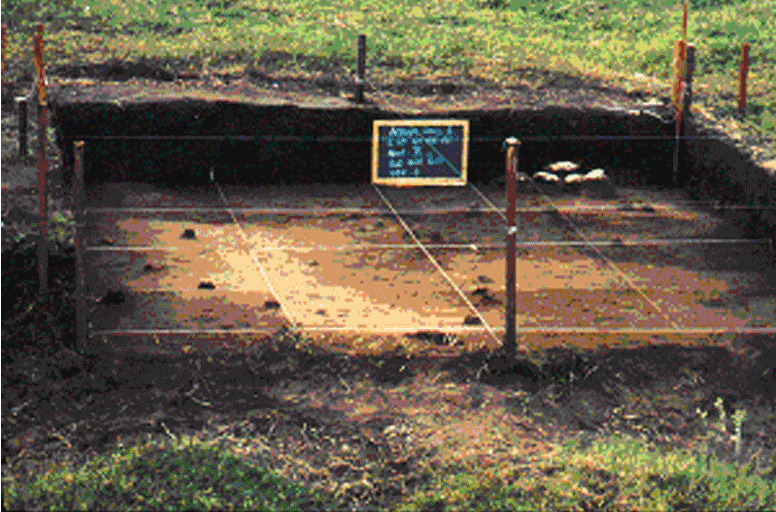
Block photographs are regularly taken across contiguous excavation units to record associations among artifacts and features revealed in the same excavation level. This critical photograph coordinates the pace at which individual excavation units are dug since the goal is to finish digging a level in all the units at approximately the same time. At Arroyo Seco, reaching the bottom of a 10 cm level in the four contiguous excavation units initiated a flurry of coordinated activity: surface cleaning with a whiskbroom, tightening of strings to square off units; preparing the chalkboard; and clearing the block of all tools, buckets, bags of artifacts, clipboards, papers, and, importantly, people. Implements were stashed outside the block and out of the camera's view, and personnel were instructed to stand back from the edges of the excavation block so their feet wouldn't appear in the final photograph.
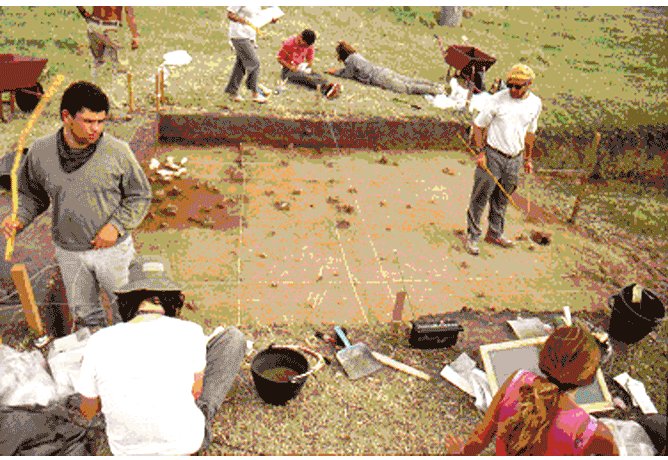
A picture of the excavation block taken while the crew is cleaning for the final photograph captures the “behind the scene” work and tools required to produce the final photograph. Compare this to the final excavation block photograph which shows a de-personalized and un-instrumented distribution of artifacts and features, a set of objective "facts" divorced from human agency and social interaction, from the array of tools and instruments and the skilled technical know-how used to produce them.
Most tellingly, we miss the elaborate sequence involved in achieving the final block photograph: the director balancing in a wheelbarrow to gain necessary elevation for the wide-angle shot, (at first supported by two women in his precarious stance,) and ultimately abandoning this tactic and requiring a substitute (lighter-weight) photographer* to mount "Rambo's" shoulders to take this shot, directly incorporating the well established social personas of available crew to achieve the objectifying perspective.
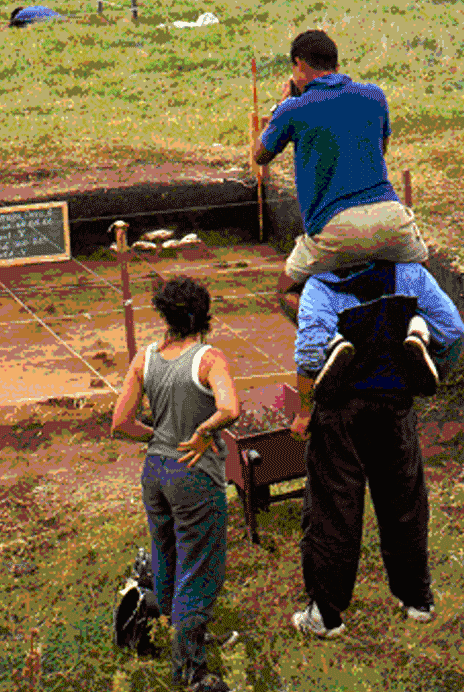
The feminist critique of science recognizes western objectification and rationality as a fundamentally masculinist mode of inquiry, one that removes all human agency and historical contingency from final products of knowledge, suggests data to be natural and automatic, and reinforces the authority of science and its designated practitioners. That data may be partial and situated, viewed and constructed differently within different historical traditions and by different pratitioners, is denied, and none of the social organization -- and engendered organization -- that underlies knowledge production is revealed.
Cognitive Autonomy
A second foundational position of scientific epistemology, cognitive autonomy, asserts that "knowers" are autonomous and self-sufficient, and the objects of knowledge are independent and separate from them (Code 1991:110). Self-sufficient rational persons, with detachment and impartial neutrality, will converge on the same knowledge because they are essentially inter-changeable self-conscious agents.
In archaeological practice (and at Arroyo Seco), the dispersion of independent field crew -- autonomous knowers --working in discrete excavation units, make observations of data that are to count equally and interchangeably in the final summation. Each cognitive agent in archaeology is to account for a spatially discrete portion of data. The rationalized and generalized (scientific) equivalency of every encounter with data is underscored by having excavators fill out unit forms, where personality and individual craftsmanship, competence and context, are erased in favor of producing a record of autonomous reason.[2]
An example from Arroyo Seco illustrates cognitive autonomy in practice, in conjunction with the practice of crafting pedestals. "Pedestals" isolate a significant find, leaving it in place on an unexcavated block of soil matrix while the rest of the level is taken down around it; the purpose of pedestalling artifacts is to observe the relational position of certain finds as they are encountered in the stratigraphy[3]
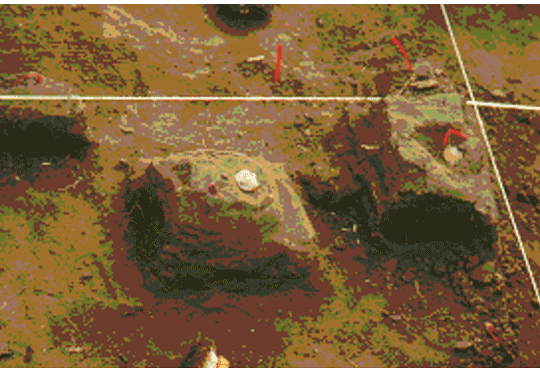
Not unexpectedly, pedestals at Arroyo Seco varied in size and form, even among equally experienced fieldworkers: Franco tended to make large, vertical-walled pedestals even for small artifacts, while Laura left artifacts on the smallest possible pedestal surface that would safely support the artifact. Franco's large pedestals were generously cut as predetermined quadralaterals; Laura's pedestals were crafted to correspond closely to the shape of the artifact.
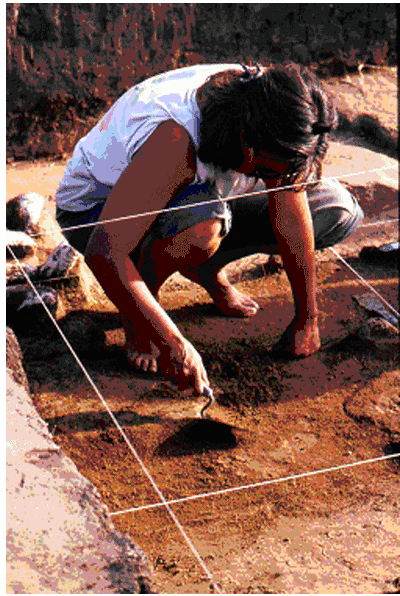
These differences in the styling of pedestals, arguably here relating to gender, should be irrelevant within the practiced assumptions of cognitive autonomy: the final level photographs and the hand-drawn level maps provide a record of artifact distributions in situ. But data also "counts" in other ways: at Arroyo Seco, the site director entered the excavation block during this pedestal-making sequence and immediately noted the large pedestals arrayed like sky-scrapers in Franco's excavation unit. He then requested a "feature photograph" be taken to record Franco's pedestalled artifacts, while Laura's small pedestals were given no special attention.
Let's not write off this incident as an instance of "bad" practice.[4] The contrast noted here is best explained, and even predicted, by common rules of practice: rendering data more clearly visible out of an “irrelevant” matrix is an expected skill, and a more ambitious, exaggerated style of identifying, isolating and highlighting data is precisely the direction of practice that is conventionally recognized as valuable and is rewarded (Lynch 1988:203-204). It is not unwarranted to argue that ambitious, even competitive heightenings of data relate to assertions of power and, moreover, to a "masculinist" pattern of practice. Franco deliberately (if unconsciously) advanced his data, pushing it -- and himself as its producer -- into the limelight of the excavation block.
The logic of autonomous reason, organizing practice, masks such relations of power through appeals to a prior, implicit, universal agreement on what is legitmately to count as an observation. This appeal to an abstract, uncontextualized and generalized neutrality is used to deny power. But in fact, the very notion of an abstracted rationality itself constitutes a powerful conceptual practice, a practice that disguises and extends its own power through appeals to objectivity (Butler 1992:6-7). And this, feminists insist, is itself the masculine cognitive mode of science that subverts women's "situated" or "partial" cognitive style.
Dichotomous A/Not-A Logic
Our third (and final) basic feature of scientific logic places first observations, and ultimately knowledge, in contradictory dichotomous categories, either A or Not-A ("true" or "not true"), eliminating intermediary positions as logically impossible. The structure of A/Not-A is such that a third term is impossible: everything and anything must be either A or Not A. Depending as they do on an empty excluded middle, the dichotomous construct of A/Not-A denies any degrees of intensity, context, or any qualifying modifiers, stripping a subject of its specificity or variance. Binary dichotomous logic presumes, requires, and thus actually creates fixed or ready-made subjects. It has as its product goal the construction and defense of universal objects of knowledge.
We turn again to the archaeology at Arroyo Seco to see A/Not-A logic in practice, demonstrated here by paired archaeological crew members who work together to construct a level map. At Arroyo Seco (as in most excavations), soil stains were mapped at the bottom of each 10 cm excavation level. Mapping teams, almost always gendered pairs, identified the shapes of soil discolorations, outlined the perimeter of each with a trowel tip to isolate the identified stain, and plotted its location from established grid points.
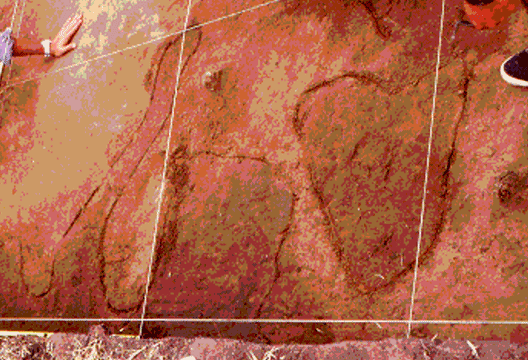
Typically (here and in many other observations of this arrangement), the woman sits outside the excavation unit as a recorder, and the man measures and calls out locational points from inside the excavation unit.
Mapping soil stains, of course, involves exactly the A/Not-A dichotomous reasoning discussed above: "stain" or "not-stain". We can now turn to gendered practice by comparing two maps from Arroyo Seco. The first drawn map shows a stain mapped in Unit 63, level 5: the perimeter of the stain had been clearly delineated and boldly outlined in the soil, then mapped in the same strong, unambiguous lines. The second map shows a stain mapped in Unit 65 level 5: here, the perimeter was not easily distinguished and had to be erased and redrawn in the soil several times until its indeterminate boundaries were most closely approximated; the corresponding map is sketched lightly in fainter lines, with layers of erasures.
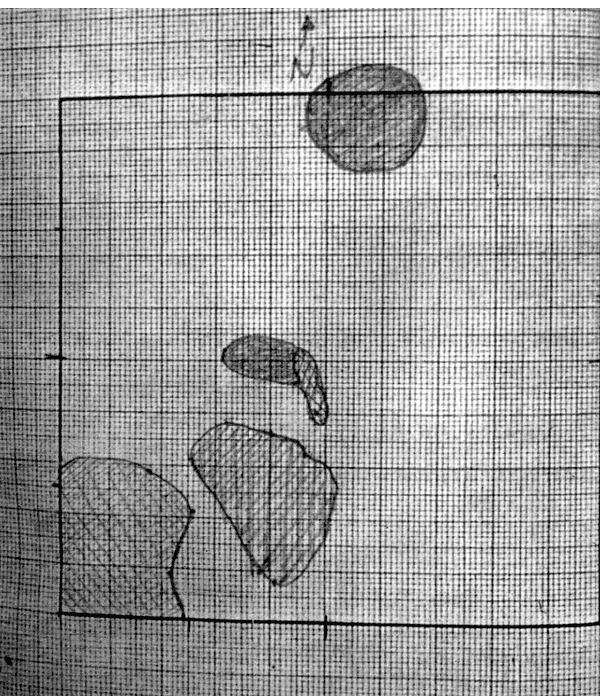
Map #1
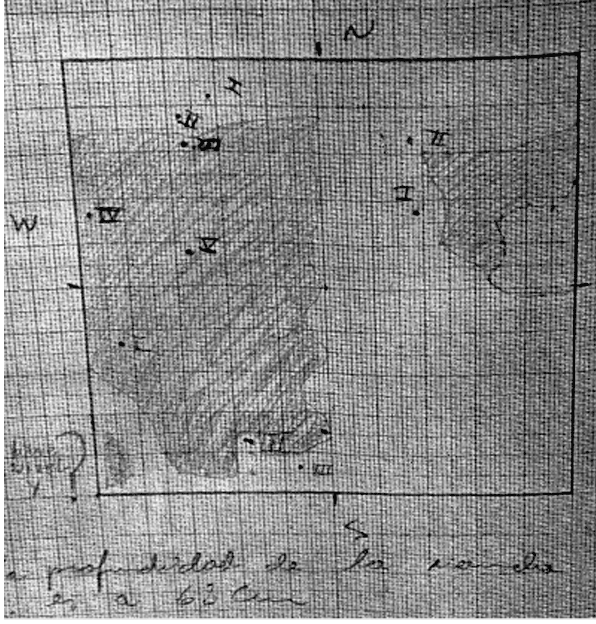
Map #2
Map #1 offers a politically powerful, easily comprehended archaeological "feature" whose producer is recognized as successfully wresting A from Not-A; this mapper moves up in the unspoken crew hierarchy in terms of cognitive skills. At the same time, Map #2 slips in importance to an indeterminate soil stain, where the available categories of “A/Not-A” could not be successfully adopted to represent the ambiguous boundaries of “Not-A”. (The first map was made by a man, the second by a woman.)
This overly-simple contrastive situation suggests a gendered pattern of science that many other women have reported felt "correct" to them, in archaeology and elsewhere in science. Women, bombarded by a gender ideology of femininity, may practice a "feminine" science in which intuition and needing to feel that one has gotten it "right" often overwhelm the politics of competing to produce clean data. It is not an insignificant pattern, despite the insignificant "sample size".[5]
Moreover, when I later discussed the gendered mapping problem with the crew, I found considerable disagreement over whether the stains were "really" more or less ambiguous in the two instances. Male crew members hotly contended that in fact the "woman's stain" was less well-defined and difficult to map than the "man's stain", while the women rejected this, insisting that before the "man's stain" took on the incontestable status of a trowel-outlined feature, the stain was barely discernable.
HOW TO MAKE FIELDWORK FEMINIST?
If we accept that conventional fieldwork practices are organized by a masculinist rationality and logic, and that gender hierarchies are not erased by these practices but are merely and dangerously masked by them, we come to the question: how do we make fieldwork feminist? What I have in mind is not digging with teaspoons instead of trowels nor marking out round instead of square excavation units. Rather, I think we as feminists and we as scientists need to adjust the logic of science to recognize agency, admit to where cognitive autonomy doesn't work, and forego forcing data into A/Not-A categories.
Archaeological research, unlike conventional science, is not replicatible; archaeological sites and depositional sequences are unique and, despite the claims of "New Archaeology", most fine-grained results cannot be rerun at another site. Since excavation is destructive, results cannot even be reviewed or reinspected once data has been collected. This lays an enormous burden on archaeological fieldworkers to lay out as much of the ambiguity and variance in the data as possible, to record especially carefully those areas where different interpretations are possible, to allow multiple accounts of what is seen. Instead of congealing the world into A/Not-A categories, and obscuring the work sequences that enhanced data by various avenues, all the reasoning and alternative reasonings that produce a data record should be highlighted. This good-sense program, perhaps not ironically, follows feminist thinking: to allow multiple voices, and experiential accounts, and situated perspectives.
Perhaps it is presumptuous for feminists to claim these directions as our own, but I will conclude first by suggesting some specific practices (some of which are already in use) that would provide multiple strains of evidence to be recorded. Excavation teams should include non-professional practitioners, amateurs and local native observers, whose untrained situated vision and perspective retain the capacity to see newly. The use of video recorders captures not only the constructed universal objects of knowledge but the nuances and variability that are lost in A/Not-A accounts of what was recovered; cam corders should record data collection on every site, and their use should be directed by technical and non-technical practitioners as well as by site directors. Field notes and field diaries, noting where uncertainty, negotiations and dissentions accompanied data recovery and classification, need to be fed into final site reports as basic interactive interpretive process and not only as footnotes to the dominant interpretive text.
Such practices are useful in capturing more than one narrative while they undermine the production of one authoritative account; in fact, they destabilize practice as we know it. The hierarchical authority of field organization, under the direction of a single principal investigator (statistically likely to be a male) who is charged with the sole interpretation of a non-replicatable, now-destroyed site, gives way to a more inclusive archaeology. Decisions are made by greater consensus, and agendas set by non-professional, community interests. The authority of the final text is redesigned and reformatted as an interactive account of what was seen by means of hypertextual, multimedia techniques of reporting fieldwork: experiential narratives interweave with reported "results" in written work, video tapes and CD ROMS permit non-linear, re-temporalized versions of work sequences to tell partial and discontinuous stories, and uninterpreted snatches of observations and experiences relevant to uncovering the past are made accessible in ancillary video banks.
* An earlier form of this article appeared as a chapter called "Archaeological Practice and Gendered Encounters with Field Data" in Gender and Archaeology , edited by Rita Wright, University of Pennsylvania Press, pages 251-280.
[1]. I am deeply endebted to Dr. Gustavo Politis and the entire field crew at Arroyo Seco for their generous tolerance of my ethnographic presence at their site for two weeks. In no way should my discussion of work at Arroyo Seco be construed as criticism of the field practices observed there; rather, my observations only carry weight because the excavations I observed were carried out at such a high level of competence.
[2]. The assumption of cognitive autonomy doesn't discount the need for new fieldworkers to learnobservational skills (Edgeworth 1991; Goodwin 1994), but it insists that independent observations should "match" and, with appropriately self-correcting measures, that such observations will accumulate rationally into bodies of knowledge.
[3]. This common excavation technique necessarily demands individual judgement in electing finds to leave "pedestalled", and depends directly upon the craft aspect of excavation, using the trowel adroitly not to discover artifacts but to render them more visible. Successful pedestalling depends on the "right" number of pedestals being left in the excavation unit: neither too many (which would complicate and clutter the visual perception of stratigraphic order and leave too much soil unexcavated) nor too few (suggesting that the excavator failed to produce valuable data). It also depends on pleasing-looking pedestals, reducing visual distraction by creating elegant, straight vertical cuts around finds.
[4]. It could be that Franco's elevated "International Visitor" status at the site (and his outgoing personality) encouraged him to magnify the importance of his finds and to exaggerate the size of his pedestals; the director may "naturally" have been hesitant to correct him and may even have wanted to give him special recognition by attending especially carefully to his work.
[5]. In addition, the woman crew member whose mapping is discussed here was new to archaeology while the mapper-man was very experienced. It therefore could be argued that the observed contrast in mapping styles is due more to inexperience than to gender. This may be so, but the contrast still reinforces the point that dichotomous thinking is learned, necessary to the politics of masculinist science, and not always easy. In the "real" world, there is no such entity as "not-stain"; the non-existent Not-A category requires ignoring or flattening all variation in soil character except that which characterizes "A". Under other rules of practice, ambiguity and indefiniteness would resolve into finer grained observations, honored as a closer scrutiny by a different eye. Had the woman mapper used the dotted line convention to represent ambiguous stain outlines, preserving A/Not-A, she would have been further along the designated masculinist road to cognitive mastery, but archaeology would not necessarily be better served: congealing the world in order to clarify it may ultimately cost more than is gained (Jay 1991:101).
Biography
Joan Gero is Professor Emerita of Anthropology from American University and a Research Fellow in the Department of Anthropology in the Museum of Natural History at the Smithsonian. She is also a lifelong fellow of Clare Hall, Cambridge, and has taught at the universities of Cambridge, Uppsala (Sweden), Catamarca (Argentina), Magdalena (Colombia) and the University of South Carolina. She has conducted archaeological excavations in the Andes (Peru and Argentina) since 1985 with grants from the National Endowment for the Humanities, National Science Foundation, Fulbright, the Wenner-Gren Foundation and the Heintz Foundation. As a pioneer scholar of gender in prehistory, she has authored dozens of articles and book chapters in professional journals and books. In 2003, she served as Academic Secretary of the Fifth World Archaeological Congress, and was head series editor of the One World Archaeology book series
References:
Butler, Judith . 1992 "Contingent Foundations: Feminism and the Question of 'Post Modernism'". In, Feminists Theorize the Political, edited by J. Butler and J. Scott, pages 3-21. New York: Routledge.
Lynch, Michael . 1988 "The External Retina: Selection and Mathematization in the Visual Documentation of Objects in the Life Sciences." Human Studies 11:201-234.
![]()
labrys,
études féministes/ estudos feministas
juillet/décembre 2012 - julho /dezembro 2012